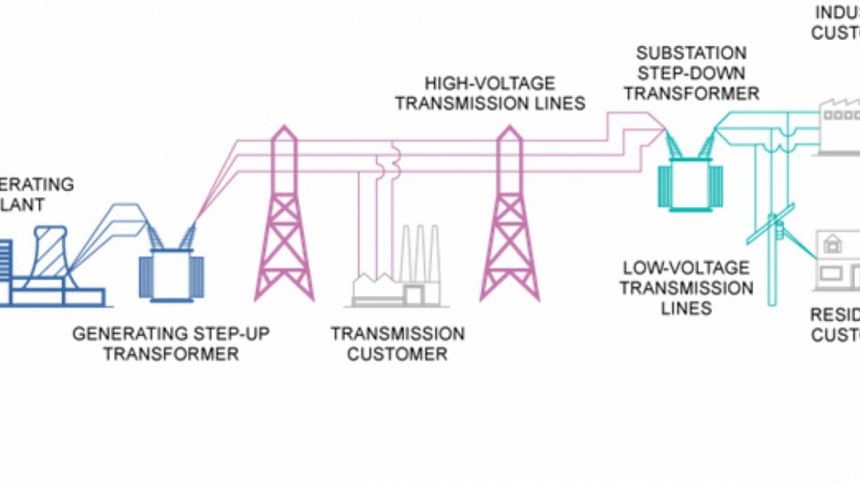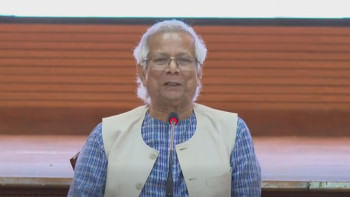Why grid failure occurs, causing a blackout

THE power grid failure that occurred in Bangladesh on 1-11-2014 was the worst blackout the country has ever experienced. The media gave different views and opinions which raised speculation about the cause. This article will try to give a brief description of grid system, its principle of operation, safety precautions and the logical reason for blackout.
Power grid system
Power grid system comprises generation, transmission, distribution and consumption. The backbone of the grid is the high-voltage overhead transmission lines that run across the country to remote areas. The power generated by the alternators in the power stations at 11KV is delivered, via step- up transformers, to the grid which transmits the electricity at 230/132 KV to the remote substations of the command centres. Distribution of electricity takes place through feeders from these substations after the line voltage is lowered back to 11 KV by step-down transformer. Medium-voltage distribution lines are erected in different places in the locality up to the step-down transformers, either at customer premises or at distribution poles, where the line voltage is further lowered down to 440/220 V, suitable for the ratings of the electrical appliances. From these field transformers, low-voltage service connections are given to the domestic and commercial customers.
In the existing grid system of Bangladesh, the network of high-voltage transmission line consists of 3,045 km at 230KV and 6,210 km at 132 KV. There are one station of 400 KV, eighteen substations of 230/132 KV and eighty eight substations of 132/33 KV.
The central load despatch centre monitors and controls the entire grid system from the work stations in the control room. It coordinates with generation and distribution to ensure a steady supply of quality electricity.
Generation in power stations
The generators in power plants are run by prime movers like turbines to produce alternating current (AC), generally at 11 KV and frequency 50 Hz, which is delivered to the grid to serve the connected loads of the end users. Power plants generate as much electricity as is consumed at a certain time as there is no scope of storage. The tolerances of electrical parameters are voltage ± 10% and frequency ±2.
A generating set is started and runs idly for some time for warming up and the governor is actuated to reach the rated speed for frequency of 50 Hz. Then using a synchroniser the set is engaged to the bus bar (which are rigid and fixed common rectangular conductors where incoming and outgoing cables are connected via breakers). In a similar way, the other sets are put on bus bar one- by-one to share the load, which is increased gradually.
When several sets run in parallel, one of them will act as the leading set. The generators can share load on auto/manual mode. The load balance done manually is more convenient, especially when some sets have capacity limitation.
Reason for blackout
Grid failure leading to blackout occurs mainly due to major imbalance between the real time generation and consumption. This is what happened on 1-11-2014 when incoming 344 MW supply from India suddenly ceased at Bheramara HVDC station. When a bulk input of power fails, the burden of this load falls on the running sets of the power plants. The sudden extra load grips the prime mover like a brake and reduces its speed momentarily. When the speed falls below the set limit of frequency, the low frequency safety guard disengages the set from bus bar. The phenomenon is termed the set tripped. A set, when it trips, is relieved instantly of the carrying load and its speed of rotation tends to increase. When the speed crosses the upper set point, the set stops due to over speed safety guard. Thus the imbalance between generation and consumption goes on increasing and the generators trip and stop in the power plants one after another, leading to cascading failures causing a widespread blackout in the country.
Restoration of power supply
Restoration of power supply is a slow process. The first step is to disengage the feeders from the grid in the substations. The generating sets have to be started, brought to the nominal frequency and put on the bus bar. A feeder in the substation has to be closed, and when it holds another is closed. This way the generating sets and feeders are put on the grid step-by-step to the full load. The restoration process involves close coordination between power plants and the load despatch centre that guides the whole process.
Safety precautions
The normal safeties of the distribution system are over-frequency, under- frequency, over-voltage, under-voltage, over-current, short circuit and earth fault. The set points and timings of the protection relays have to be maintained uniformly. The control cabinet rooms have to be dust free and air conditioned to prevent malfunction.
The modern 400 KV, 500 MW back-to-back HVDC cross country transmission line between Bahrampur and Bheramara is a new experience for Bangladesh. It is known that addition of HVDC system makes a weak grid strong and stable. The advantage of HVDC technology is that its converter station is capable of absorbing the fluctuations, and can prevent widespread blackout. Unfortunately, the HVDC back-to-back station at Bheramara failed to perform the duty of blackout preventer when a glitch, a transient fault, occurred, followed by countrywide power failure. The safeties and control strategy of the converter station needs attention and fixing based on performance analysis.
Development of grid system
The prime duty of the national grid is to ensure transmission and distribution of quality electricity with specified voltage and frequency. To ensure stability, the grid system should be balanced regionally to reduce line loss, be equipped with a smart data communication and monitoring system, have reliable safeties for the equipments, and capabilities to optimise the reactive power to improve efficiency.
Power Grid Company of Bangladesh Ltd. (PGCB) is looking after the operation, maintenance and development of the high voltage grid system. The existing grid is old and weak and there is scope for improvement according to the recommendations given by experts in the past. PGCB has to continue infrastructural development programmes to build new high-voltage transmission lines and substations to serve the upcoming new power plants to meet the ever increasing demand for electricity. It may also explore the possibility to make room for the captive power in the country to contribute to the system.
Blackout is an unusual occurrence in power supply system. Even a strong and stable grid can hardly withstand the thrust caused by a sudden disappearance of a substantial input from the system. The best way of prevention is round-the- clock liaison between generation and distribution. A power plant, when faced with a problem, can immediately alert the load despatch centre that can take cautionary steps before it is too late. The planned 1,000 MW HVDC stations, when built, will go a long way to prevent blackout in future.
The writer is Senior Mechanical Engineer.
Email: [email protected]

 For all latest news, follow The Daily Star's Google News channel.
For all latest news, follow The Daily Star's Google News channel. 



Comments